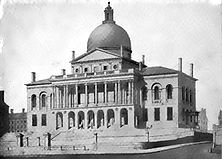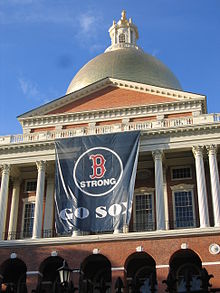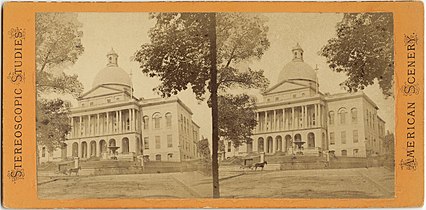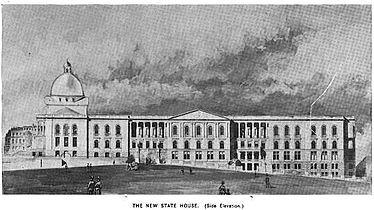Massachusetts State House
Massachusetts Statehouse | |
U.S. National Register of Historic Places | |
U.S. National Historic Landmark | |
U.S. Historic district Contributing property | |
 The Massachusetts State House | |
 | |
| Location | Boston, Massachusetts |
|---|---|
| Coordinates | 42°21′29.4″N 71°3′49.3″W / 42.358167°N 71.063694°W / 42.358167; -71.063694Coordinates: 42°21′29.4″N 71°3′49.3″W / 42.358167°N 71.063694°W / 42.358167; -71.063694 |
| Built | 1795–1798 |
| Architect |
|
| Architectural style | Federal |
| Part of | Beacon Hill Historic District (#66000130) |
| NRHP reference # | 66000771 |
| Significant dates | |
| Added to NRHP | October 15, 1966[1] |
| Designated NHL | December 19, 1960[2] |
| Designated CP | October 15, 1966 |

Stereograph image of the Massachusetts State House c. 1862, before the addition of wings. The copper dome was first painted gray to appear as stone, and then was gilded in 1872.

The front gate of the State House, located on Beacon Street.

1827 drawing by Alexander Jackson Davis

The State House displaying a banner in honor of the Boston Red Sox's 2013 World Series appearance
The Massachusetts State House, also known as the Massachusetts Statehouse or the New State House, is the state capitol and seat of government for the Commonwealth of Massachusetts, located in the Beacon Hill/Downtown[3][4] neighborhood of Boston. The building houses the Massachusetts General Court (state legislature) and the offices of the Governor of Massachusetts. The building, designed by architect Charles Bulfinch, was completed in January 1798 at a cost of $133,333 (more than five times the budget), and has repeatedly been enlarged since. It is considered a masterpiece of Federal architecture and among Bulfinch's finest works, and was designated a National Historic Landmark for its architectural significance.[5]
Contents
1 Building and grounds
2 Dome
3 Statuary
4 Inside the building
5 In literature
6 In movies
7 In video games
8 Image gallery
9 See also
10 Notes
11 References
12 Further reading
13 External links
Building and grounds
The building is situated on 6.7 acres (27,000 m2) of land on top of Beacon Hill in Boston, opposite the Boston Common on Beacon Street. It was built on land once owned by John Hancock, Massachusetts's first elected governor.[6] The Masonic cornerstone ceremony took place on July 4, 1795, and was presided over by Paul Revere, Deputy Grand Master of the Grand Lodge of Massachusetts.
Before the current State House was completed in 1798, Massachusetts's government house was the Old State House on what is now Washington Street. For the building's design, architect Charles Bulfinch made use of two existing buildings in London: William Chambers's Somerset House,[7] and James Wyatt's Pantheon.[8]
After the state of Maine separated from the Commonwealth of Massachusetts and became a state in 1820, that state's capitol building was built with architectural influence of the Massachusetts Capitol building with a simplified Greek Revival influence.
A major expansion of the original building was completed in 1895.[9] The architect for the annex was Bostonian Charles Brigham.
In 1917, the east and west wings, designed by architects Sturgis, Bryant, Chapman & Andrews, were completed.[10]
In July 2016, Governor Charlie Baker proposed to the state legislature to sell 300 square feet (28 m2) of permanent easement on the west side of the State House lawn to a neighboring condominium. The land in question was once pasture owned by John Hancock and the easement would allow for the addition of au pair units.[11]
Dome
The original wood dome, which leaked, was covered with copper in 1802 by Paul Revere's Revere Copper Company. Revere was the first American to roll copper successfully into sheets (for copper sheathing) in a commercially viable manner.
The dome was first painted gray and then light yellow before being gilded with gold leaf in 1874. During World War II, the dome was painted gray once again, to prevent reflection during blackouts and to protect the city and building from bombing attacks.[12] In 1997, at a cost of more than $300,000, the dome was re-gilded, in 23k gold.
The dome is topped with a gilded, wooden pine cone,[13] symbolizing both the importance of Boston's lumber industry during early colonial times and of the state of Maine, which was a district of the Commonwealth when the Bulfinch section of the building was completed.
Statuary
In front of the building is an equestrian statue of General Joseph Hooker. Other statues in front of the building include Daniel Webster, educator Horace Mann, and former US President John F. Kennedy. The statues of Anne Hutchinson and Mary Dyer are located on the lawns below the east and west wings.
Inside the building
The original red-brick Bulfinch building contains the Governor's offices (on the west end) with the Massachusetts Senate occupying the former House of Representatives Chamber under the dome. The Massachusetts House of Representatives occupies a chamber on the west side of the Brigham addition. Hanging over this chamber is the "Sacred Cod", which was given to the House of Representatives in 1784 by a Boston merchant. The Sacred Cod symbolizes the importance of the fishing industry to the early Massachusetts economy.[14]
The second floor under the dome is decorated by murals painted by artist Edward Brodney.[15] Brodney won a competition to paint the first mural in a contest sponsored by the Works Progress Administration in 1936. It is entitled "Columbia Knighting Her World War Disabled." Brodney could not afford to pay models, and friends and family posed. The model for Columbia was Brodney's sister Norma Brodney Cohen, and the model for the soldier on one knee in the foreground was his brother Fred Brodney. In 1938, he painted a second mural under the dome called "World War Mothers." The models were again primarily friends and family members, with sister Norma sitting beside their mother Sarah Brodney.[16] The New York Times notes that the murals are relatively rare examples of military art with women as their subjects.
A staircase in front of the Bulfinch building leads from Beacon Street to Doric Hall inside the building. The large main doors inside Doric Hall are only opened on three occasions:[17]
- When the President of the United States or a foreign head of state visits.
- When the Governor exits the building on his or her last day in office. This tradition is known as the Long Walk and begins when the Governor, alone, exits the Executive Chamber, walks down to the second floor, through Doric Hall, and out the main doors. He or she then descends the staircase, crosses Beacon Street, and enters Boston Common, symbolically rejoining the people of Massachusetts as a private citizen. The tradition has been interrupted during recent years. Governor William Weld descended the staircase on his last day in office July 29, 1997, meeting his successor then-Lt.Governor A. Paul Cellucci on the stairs. Four years later, then-Governor Cellucci was deprived of his symbolic chance to descend the State House steps because of ongoing renovations to the front of the building. Acting Governor Jane Swift elected to walk down the stairs with her family before departing for the Berkshire Mountains. On January 4, 2007, Deval Patrick chose to be sworn in on the staircase and give his inaugural address there, forcing outgoing Governor Mitt Romney to take the Long Walk the day before his last in office.[18]
- When a regimental flag is returned from battle. Since the regimental flags now return to Washington, D.C., this has not been done since the Vietnam War.
The Samuel Adams and Paul Revere time capsule is a metal box located in a cornerstone of the State House, placed there in the late 18th century and rediscovered in 2014. The contents include coins, newspaper clippings and other historical artifacts.
In literature
One of Boston's most enduring nicknames, "The Hub of the Universe",[19] is from a remark by Oliver Wendell Holmes from his 1858 book The Autocrat of the Breakfast-Table in which he mentions the State House (emphasis added):
.mw-parser-output .templatequote{overflow:hidden;margin:1em 0;padding:0 40px}.mw-parser-output .templatequote .templatequotecite{line-height:1.5em;text-align:left;padding-left:1.6em;margin-top:0}
A jaunty-looking person ... said there was one more wise man's saying that he had heard; it was about our place—but he didn't know who said it. ... Boston State-House is the Hub of the Solar System. You couldn't pry that out of a Boston man if you had the tire of all creation straightened out for a crow-bar.[20]
In movies
In the 1982 film The Verdict, the State House interior is used as both a court house and hospital.
The State House is featured prominently in the 2006 film The Departed as a symbol of the ambition of the antagonist, Colin Sullivan.
In video games
In the 2013 game The Last of Us, both the interior and exterior of the building are depicted. It is required to go through the whole building, which has been partially destroyed.
The State House is featured in Fallout 4, a video game by Bethesda Softworks.
Image gallery

Aerial view of State House from Boston Common

View of the city of Boston from Dorchester Heights, 1841; State House at top of hill
Interior, House of Representatives, 1856

Dedication of Daniel Webster statue, 1859. Photograph by Deloss Barnum

State House, 19th century

Interior, House of Representatives, 19th century

1892

c. 1895

Interior, 2005

The façade of the building at night
See also
- List of National Historic Landmarks in Boston
- National Register of Historic Places listings in northern Boston, Massachusetts
Notes
^ National Park Service (2006-03-15). "National Register Information System". National Register of Historic Places. National Park Service..mw-parser-output cite.citation{font-style:inherit}.mw-parser-output q{quotes:"""""""'""'"}.mw-parser-output code.cs1-code{color:inherit;background:inherit;border:inherit;padding:inherit}.mw-parser-output .cs1-lock-free a{background:url("//upload.wikimedia.org/wikipedia/commons/thumb/6/65/Lock-green.svg/9px-Lock-green.svg.png")no-repeat;background-position:right .1em center}.mw-parser-output .cs1-lock-limited a,.mw-parser-output .cs1-lock-registration a{background:url("//upload.wikimedia.org/wikipedia/commons/thumb/d/d6/Lock-gray-alt-2.svg/9px-Lock-gray-alt-2.svg.png")no-repeat;background-position:right .1em center}.mw-parser-output .cs1-lock-subscription a{background:url("//upload.wikimedia.org/wikipedia/commons/thumb/a/aa/Lock-red-alt-2.svg/9px-Lock-red-alt-2.svg.png")no-repeat;background-position:right .1em center}.mw-parser-output .cs1-subscription,.mw-parser-output .cs1-registration{color:#555}.mw-parser-output .cs1-subscription span,.mw-parser-output .cs1-registration span{border-bottom:1px dotted;cursor:help}.mw-parser-output .cs1-hidden-error{display:none;font-size:100%}.mw-parser-output .cs1-visible-error{font-size:100%}.mw-parser-output .cs1-subscription,.mw-parser-output .cs1-registration,.mw-parser-output .cs1-format{font-size:95%}.mw-parser-output .cs1-kern-left,.mw-parser-output .cs1-kern-wl-left{padding-left:0.2em}.mw-parser-output .cs1-kern-right,.mw-parser-output .cs1-kern-wl-right{padding-right:0.2em}
^ "Massachusetts Statehouse". National Historic Landmark summary listing. National Park Service. Archived from the original on 2012-09-06. Retrieved 2008-07-06.
^ "Neighborhoods: Downtown". City of Boston. Retrieved October 2014. Check date values in:|accessdate=(help)
^ "Electoral Maps". Boston Redevelopment Authority. Retrieved October 2014. Check date values in:|accessdate=(help)
^ "NHL nomination for Massachusetts State House". National Park Service. Retrieved 2015-02-22.
^ https://www.sec.state.ma.us/trs/trsbok/exterior_tour.pdf
^ Shand-Tucci, Douglass. Built in Boston: City and Suburb, 1800–2000, p. 6. University of Massachusetts Press, Amherst, 1999.
ISBN 1-55849-201-1.
^ Whiffen, Marcus, and Koeper, Frederick. American Architecture, 1607–1976. Routledge (1981), p. 110.
ISBN 0-7100-0813-9.
^ "A Guide to the Massachusetts State House". Mass.Gov. Retrieved 8 June 2015.
^ Exterior Tour
^ Phillips, Frank (2016-07-21). "Baker wants to sell part of State House lawn". The Boston Globe. Retrieved 2016-07-21.
^ http://www.thefreedomtrail.org/freedom-trail/state-house.shtml
^ "Massachusetts State House". Retrieved 2016-07-21.
^ Massachusetts State House, via cityofboston.gov
^ Martin, Douglas (2002-08-19). "Edward Brodney, 92, Who Painted War Scenes". The New York Times. Retrieved 2008-10-21.
^ "Boston Women's Heritage Trail". Retrieved 2009-11-26.
^ "Massachusetts Facts Part 3, The State House, Doric Hall". Office of the Secretary of the Commonwealth of Massachusetts. Retrieved 20 January 2017.
^ "Patrick Vows Inclusion in Inaugural Address". The Boston Globe. January 5, 2007.
^ "Boston's nicknames: Beantown, Hub, the Walking City". The Boston Globe. August 10, 2006.
^ Holmes, Oliver Wendell (1858). The Autocrat of the Breakfast-Table. Phillips, Sampson and Company.; Holmes, Oliver Wendell (1891) [1858]. The Autocrat of the Breakfast-Table. Houghton, Mifflin and Company.
p. 172
References
Cupolas of Capitalism - State Capitol Building Histories (L-ME) (1998–2005). Cupola.com. May 17, 2005.
The Evolution of the State House (2005). Interactive State House. Mass.gov . May 17, 2005.
Further reading
- Arthur Milnor Bridgman. A Souvenir of Massachusetts legislators. Stoughton, Mass.: A.M. Bridgman, 1908.
- Harold Kirker. Architecture of Charles Bulfinch. Cambridge, Massachusetts: Harvard University Press, 1969.
External links
| Wikimedia Commons has media related to Massachusetts State House. |
- A Tour of the Massachusetts State House
- Boston National Historical Park Official Website
Images of State House, various dates (via State Library of Massachusetts on Flickr)
| Preceded by Boston Common | Locations along Boston's Freedom Trail Massachusetts State House | Succeeded by Park Street Church |










